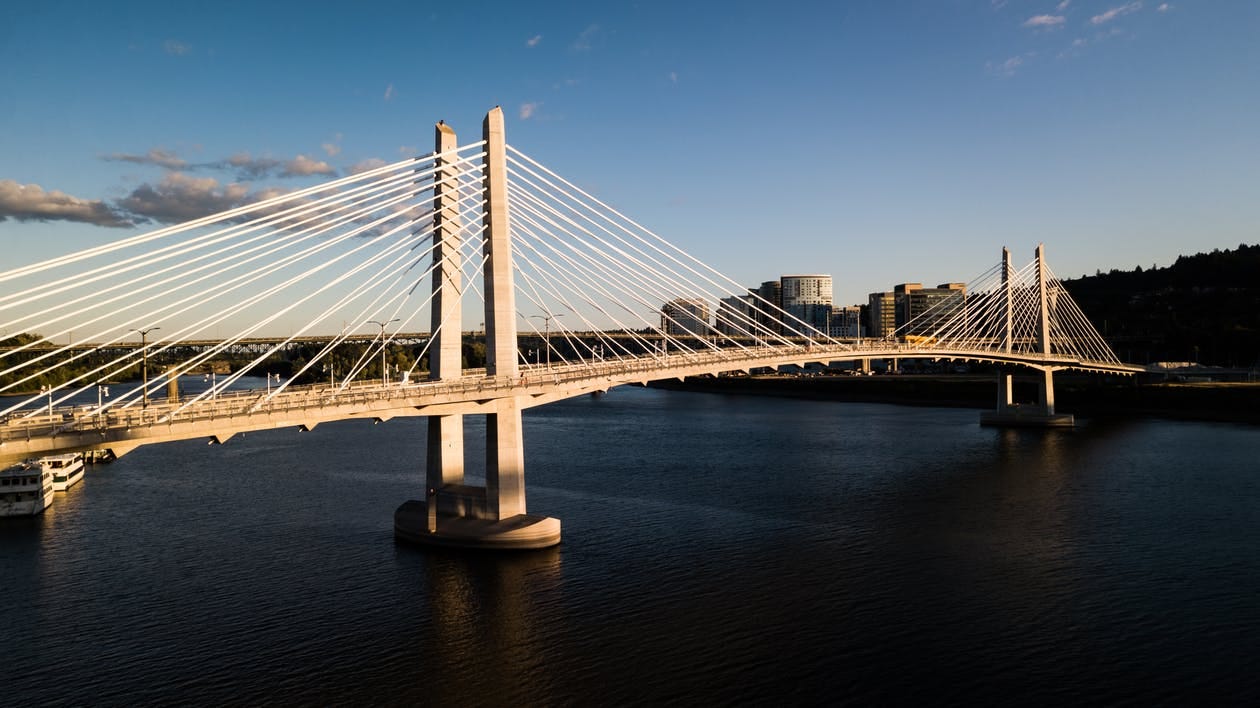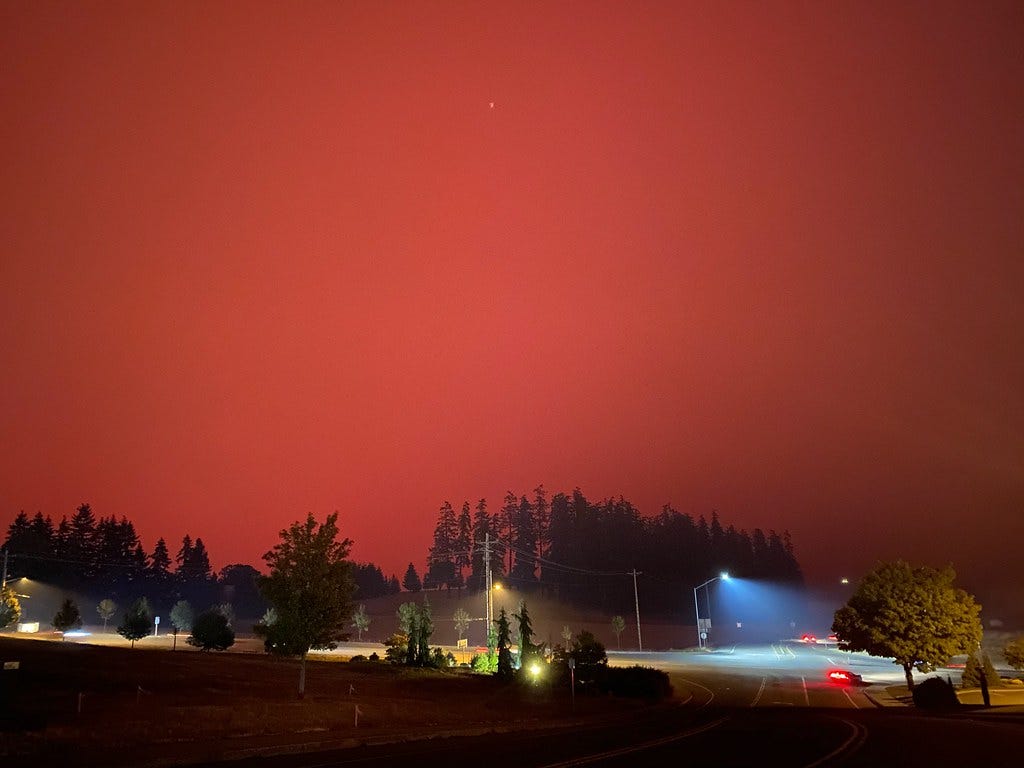The Liftoff: "Deborah and Ted", Oreos, flip-flops, redistricting, notable goodbyes, and more!
PLUS: Legislators offer personal memories of where they were on 9/11/01, fantastic writing on Oregon wildfire anniversaries, and the future of Oregon's economy.
Welcome to another installment of The Liftoff: the newsletter with everything you need to know about Oregon politics, government, campaigns, and elections.
Before we dive in, we have to brag. Portland Monthly gave us a shoutout as one of “3 Oregon Substacks Worth the Space in Your Inbox”, saying we’re a “rational exploration of Oregon’s common underpinnings in a time of extreme polarities.” It goes on: “the tone is more collaborative and straightforward, and the contributor’s list is a who’s who of the Oregon political scene. Come for the weekly round-up of behind-the-scenes political news; stay for the searching, thoughtful analysis.”
Thank you to all our subscribers, paid and free. If you’d like to follow Portland Monthly’s advice and become a founding member, just click the link below!
1. Looper and Lavey of “People for Portland” name names
Two very revealing interviews this week from the powerful political consultants behind “People for Portland”, Kevin Looper and Dan Lavey. The first, by Nigel Jaquiss in Willamette Week, has a couple of fascinating tidbits:
Apparently Mayor Ted Wheeler’s aide Sam Adams said about People for Portland: “This is good. We need pressure.” Wheeler and the Portland City Commission are, of course, primary targets of the group.
A question from Jaquiss indicates that Multnomah County Commissioner Sharon Meieran may run for County Chair (Commissioner Jessica Vega Pederson announced last week). Here’s the question to Looper: “You wrote an op-ed in The Oregonian. The next week, County Commissioner Sharon Meieran wrote a similar one. Kevin, you ran her campaign four years ago. Is this campaign part of helping her run for chair next year?” (Looper said no).
The second interview, in Portland Monthly, is a wild ride (starting with the intro, including this description of the two consultants: “two middle-aged white guys who know their way around the Arlington Club”). Some highlights:
First, this quote from Looper: “The problem is the political system is broken.”
This is very reminiscent of Nick Kristof’s trial ballon for a potential run for governor, when he said: “We need new leadership from outside the broken political system.”
Another Looper quote: “We need put the focus back where it belongs on actual decision makers. Deborah and Ted—sorry, first names, but I’m familiar with these folks—they’d rather blame each other than figure out how to change the process.” Ouch.
2. What is happening with redistricting?
The redistricting saga continued this week with public comment from dozens and dozens of people. Among those who provided testimony include: Mayor Lacey Beaty (Beaverton), Mayor Jason Snider (Tigard), Mayor Teri Lenahan (North Plains), Washington County Commissioner Jerry Wiley, Former Rep. Margaret Doherty, Jamie McLeod Skinner, the Springfield Chamber of Commerce, former Rep. Deborah Boone, and many, many more. More testimony will be heard this week.
After perusing dozens of comments, it’s clear that advocacy groups have been working hard to whip up support (and sometimes opposition) for certain plans. It’s also clear that some folks were understandably confused by the process. One woman asked the committee not to change her children’s school district boundaries. One man simply wrote this: “I DO NOT SUPPORT REDISTRICTING ANYWHERE IN THE STATE OF OREGON.” Fair enough.
If you’re looking for a deeper dive, The Oregonian provided excellent analysis this week on what the new maps would actually mean (including examples of multiple incumbents being drawn into the same district).
The reality is none of the current maps will be what the final boundaries actually look like. If the legislature is going to agree on legislative boundaries (still very uncertain), it seems likely the final maps will look more like Map A (the only proposal that included bipartisan input, if not bipartisan support), rather than Map B (House Republicans’ map) or Map C (House Democrats’ map).
The congressional maps are another story; a compromise here is harder to imagine, given how far apart the two proposals are. But we believe in Oregon miracles.
Governor Kate Brown has called the Special Session, which will focus only on redistricting, for September 20th.
3. “The Battle of High Hill” and what we learned from last year’s fires
If you haven’t read this new, long-form story on last year’s Labor Day fires yet, you must. It’s called “The Battle of High Hill” by Jeffrey Stern in The Atlantic. My dad sent it to me last week and it’s one of the most captivating and inspiring pieces of writing I’ve read in a long time. Don’t be surprised if tears fall as you read it, remembering where you were one year ago when the skies were deep red.
Here’s an excerpt about the Beachie Creek Fire:
Gales gave the order to evacuate. Staff members ran for their cars. Most had to abandon their equipment. The team fled west on Highway 22, intending to regroup in Mill City, three miles ahead of the fire. Before they could assemble, flames bore down on Mill City. The team fled farther west, to Stayton and then to Keizer. The fire followed, then slipped down into Little North Santiam Canyon, where residents who had gone to bed thinking danger was many miles away awoke to thumps on the roof. The fire was lobbing tree branches like mortar rounds. Embers lit the ground. The sky glowed orange. The fire was growing by nearly three acres a second, sucking oxygen out of the canyon.
Falling trees and whirling branches blocked escape by car. Those trying to run found the asphalt so hot that it burned through their shoes. Some people were overcome by lack of oxygen. The fire would soon claim its first lives. The state forestry office in Santiam Canyon was overtaken and destroyed. Up-to-date information was scant. The firefighters and Forest Service workers evacuating Detroit initially fled toward the fire rather than away from it.
Don’t worry—the ending of this story will leave you inspired.
There was a wealth of fantastic reporting on wildfires (and associated issues) this week, including these important pieces:
“Wildfires took these families’ homes. Here’s why they stay,” This New York Times story is a gut-wrenching portrait of survivors of the Almeda fire. A sample:
“I know I can start over in another place, but I don’t want to run away like a coward and not face my problems. I want to rebuild. I want a little piece of property so if something happens, we can come back. I don’t want anything for free. I want a chance, for somebody to believe in us and say, ‘OK, I’m going to lend you that money.’”
“The Labor Day fires burned towns and homes. Oregon has a plan to avoid a repeat” from OPB explores what the state has learned from last year’s fires.
Jefferson Public Radio has an important write-up on the inequities of wildfire smoke called “Sheltering Inside May Not Protect You From The Dangers Of Wildfire Smoke”. Here’s an alarming excerpt:
“Coefield helped author a study with the Environmental Protection Agency that looked at air quality inside public buildings and businesses during wildfire smoke events in Missoula, Mont. They placed air monitors in daycares, schools, libraries, businesses and other publicly accessible buildings — the types of places that health officials like Coefield generally recommend people go to during smoke or heat events.
‘We did not have a single building with air that was, like, significantly better than outside,’ Coefield said. ‘Some of the buildings, you might as well have been outside.’”
4. Oregon legislators remember where they were on 9/11

This week, we wanted to share these memories posted on social media by Oregon legislators offering their personal 9/11 experiences.
State Rep. Rachel Prusak, who was a “young nurse working in New York” on 9/11, wrote: “That morning, we placed every operating room on hold for survivors from the towers. They did not arrive. We mourned together. We celebrated the small miracles. We put aside our differences. Lines to donate blood stretched around the block. We worked through the shock, the sadness, the anger, the immense loss.”
State Rep. Karin Power, originally from New Jersey, wrote: “Twenty years ago, I sat in my first world politics class. My professor rushed in, crying, and announced that the US had been attacked. Back in our dorms, I sat with strangers and held hands as we watched the towers fall and frantically tried to reach friends and family who worked or lived in the city.”
State Rep. Andrea Salinas, who was a “young congressional aid, working in our nation’s Capitol”, wrote: “I had a front-row seat to witness how our first responders—firefighters, law enforcement, secret service agents, and national guard—gave selflessly on that day. And I will always have survivor’s guilt and never forget the sacrifice that the passengers on United Airlines 93 made for those of us working in the Capitol.”
For an unbelievable podcast episode on the Flight 93 story, whose passengers indeed saved the lives of members of congress and congressional staff, I highly recommend “Sacred Ground: A 9/11 Story” from The NPR Politics Podcast.
Finally, a haunting pieces that I come back to each anniversary of 9/11: “The Falling Man” by Tom Junod. It’s about photography, an unidentified man who jumped from the North Tower on 9/11, families who lost loved ones, our collective trauma, ethics, and more.
5. Nabisco strike doubles as campaign stop; Novick boosts Oreo competitor
The picket line in front of the Mondelez Nabisco factory in NE Portland has become a must-stop location for Democratic politicians heading into the 2022 campaign season. Speaker Tina Kotek, Treasurer Tobias Read, Reps. Wlnsvey Campos and Dacia Grayber, Portland City Commissioners JoAnn Hardesy and Carmen Rubio, former Rep. Akasha Lawrence Spence, and Multnomah County Commissioner Lori Stegmann have all made appearances over the last month or so.
For background on why the strike is happening, including interviews with several of the workers on strike, check out this reporting from Street Roots: “Workers at Nabisco's North Portland cookie plant rally as strike continues”. Here’s an excerpt:
After Mondelez recorded more than $3.5 billion in profits in 2020, workers said the company’s demands for 12-hour work days, no overtime or holidays off and reduced healthcare coverage is unacceptable.
The picket has escalated in recent days, with threats of legal action by Mondelez against the union.
Former Portland City Commissioner Steve Novick and Thomas Mosher have created a unique effort to support the strike: encouraging people to buy Hydrox instead of Oreos. Here’s an excerpt from his newsletter:
We decided to launch a "Don't Be A Scab. Buy Hydrox" campaign. We figure Nabisco might be more affected by the idea of people switching products than by a boycott alone. If Nabisco starts seeing a lot of Facebook and Twitter posts saying "don't be a scab. Buy Hydrox," maybe they'll get nervous. And if Hydrox sales actually start going up, Nabisco should really get nervous.
Novick is encouraging people to contact their local grocery store and ask them to start carrying Hyrdox.
6. A week of flip-flops and backtracks in Portland
It was a(nother) tough week for Portland.
The Portland City Commission was set to vote to ban business with Texas, following the passage of the new Texas abortion law—then it changed it’s mind (the vote is delayed).
Portland and Multnomah County were set to require all police officers be vaccinated against COVID-19—then they had to change their mind (the state said law enforcement officers cannot be interpreted as health care workers).
After originally “claiming victory” regarding the police strategy on the Antifa vs. Proud Boys battle in Parkrose, Mayor Ted Wheeler now says: “It is clear based on the public outcry, on the media outcry, on the national front, that that strategy was not the right strategy. I take full responsibility for it.”
But, for all the national ridicule and bad press Portland has endured, people still want to live there. According to Axios’ reporting, Portland is the number 17 “Top Inbound City” in the United States in 2021, up 6 spots from 2020.
7. This week in notable goodbyes
State Rep. Bill Post will not run for reelection, citing “self-imposed term limits”
Because of the financial risk, Oregon State University “doesn’t want to own the Elliot State Forest anymore”
Reagan Knopp is leaving his role as political director at Oregon Right to Life
Former Salem-Keizer School Board member, Keizer City Councilor, and Independent candidate for the state house Chuck Lee has passed away at 72
Former Portland State University Professor Peter Boghossian (known for publishing hoax journal articles) quit his job
8. The future of Oregon’s economy: addressing labor market inequities?
The Oregon Office of Economic Analysis is out with some great insight that seems to bridge the left’s call for a more inclusive, equitable society and the right’s call for a more robust economy, including a larger workforce.
Here’s a summary: “The upshot of addressing [employment disparities by race, gender, and age, and educational attainment] in Oregon, is that they have the potential to boost the labor supply much more than any realistic increase in migration ever could. By hiring to a greater degree from Oregon’s existing residents, firms would be able to tap into a much larger pool of labor in order to expand and grow. Such an outcome would be a win-win for society and the economy.”
The takeaway? “Bottom Line: Addressing economic disparities raises the potential of the entire economy. Local businesses have a larger pool of workers to choose from than many believe due to the historical underutilization of many segments of the population. Faster migration in the years ahead will grow the economy, however even if stronger migration gains do not materialize, there remains considerable upside risk to Oregon’s economic and revenue growth.”
In related news, the Technology Association of Oregon has launched an initiative to “create economic growth and increase diversity in tech by helping startups led by traditionally underrepresented founders build strong companies”.
9. One infographic to go: Tom McCall would be proud
Our friends at the Oregon Value and Belief Center put together this research graphic that shows Oregonians—across the “urban-rural divide”—largely agree that environmental protection should be prioritized over economic growth.
Thank you for reading.
Tips? Feedback? Ideas? Corrections? We want to hear from you! Email benjaminwbowman@gmail.com.
If you value this newsletter, please become a paying subscriber today. Your support will help us grow and offer more opportunities to this community. It’s just $10 a month!











